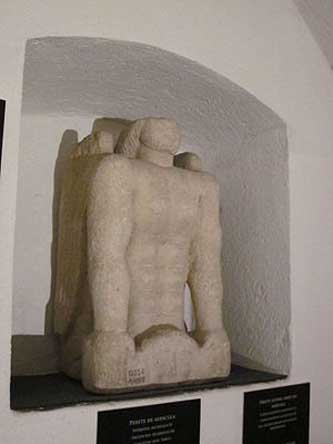
The sphinx archetype appeared in various forms among other ancient cultures of Western Asia and the Mediterranean, notably in Mesopotamia, Greece, and Etruria. Wings were often added to the leonine body, and female sphinxes were also created, especially in Greece (8th-6th century BC).

The Sphinx is said to have guarded the entrance to the Greek city of Thebes, and to have asked a riddle of travelers to allow them passage. The exact riddle asked by the Sphinx was not specified by early tellers of the stories, and was not standardized as the one given below until late in Greek history.
It was said in late lore that Hera or Ares sent the Sphinx from her Ethiopian homeland (the Greeks always remembered the foreign origin of the Sphinx) to Thebes in Greece where she asks all passersby the most famous riddle in history: "Which creature in the morning goes on four legs, at mid-day on two, and in the evening upon three, and the more legs it has, the weaker it be?" She strangled and devoured anyone unable to answer.
Oedipus solved the riddle by answering: Man - who crawls on all fours as a baby, then walks on two feet as an adult, and then walks with a cane in old age. By some accounts (but much more rarely), there was a second riddle: "There are two sisters: one gives birth to the other and she, in turn, gives birth to the first." (answer: day and night—both words are feminine in Greek.) Bested at last, the tale continues, the Sphinx then threw herself from her high rock and died.
An alternative version tells that she devoured herself. Thus Oedipus can be recognized as a "liminal" or threshold figure, helping effect the transition between the old religious practices, represented by the death of the Sphinx, and the rise of the new, Olympian deities.
The person behind the Great Sphinx has been a subject of debate. While there is no contemporaneous evidence indicating with certainty whom it represents, the Dream Stele erected by Pharaoh Thutmose IV in the New Kingdom associates the Sphinx with King Khafra (also known by the Hellenised version of his name, Chephren).
This would place its construction during the Fourth dynasty of Egypt (2723 BC-2563 BC). Its super-colossal design is characteristic of Old Kingdom architecture, especially during Khafra's reign. Khafra is known to have ordered the building of twenty-two stone structures that were more than three times life-size, but the largest is believed to be the Great Sphinx. The Sphinx's link with Khafra therefore continues to be the most widely held view by Egyptologists, but other hypotheses exist.
In 2004, French Egyptologist Vassil Dobrev announced the results of a 20-year reexamination of historical records and uncovering of new evidence that suggest the Great Sphinx may have been the work of the little known Pharaoh Djedefre, Khafra's half brother and a son of Khufu (Cheops), the builder of the Great Pyramid of Giza. Dobrev suggests it was built by Djedefre in the image of his father Khufu, identifying him with the sun god Ra in order to restore respect for their dynasty.
In common with many famous constructions of remote antiquity, the Great Sphinx has over the years attracted speculative assertions by non-specialists, mystics, and general writers. The reasons for these alternative theories of the origin, purpose and history of the monument invoke a wide array of sources and associations, such as neighboring cultures, astrology, lost continents and civilizations (e.g. Atlantis), numerology, mythology and other esoteric subjects.
Egyptologists and the wider scientific community largely ignore such claims; however, on occasion they are drawn into public debate with these theorists, particularly when the claim purports to rely upon some novel or re-interpreted data from an academic field of study.
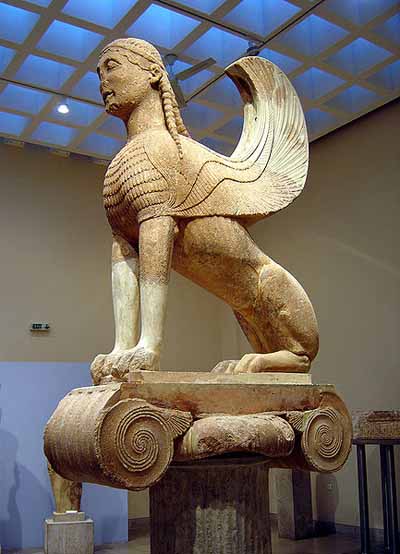
Ancient Greek Sphinx from Delphi
The Sphinx sometimes appears in Greek mythology as a monster with a woman's head and breasts, dog's body, lion's paws, wings of an eagle, and the tail of the serpent-who questioned Oedipus.
To the ancient Egyptians, the Great Sphinx symbolically represented the Nile and its seasons. She was also a manifestation of Hathor, Goddess of birth and death. The Sphinx was built as guardian of the horizons, the rising and setting sun. It held the keys to the wisdom gates. In the path to deep knowing, initiates had to confront the challenges that the Sphinx posed.
Crisophinx (lion body with ram head)
Hierocosphinx (lion body with hawk head)
Androsphinx (lion body with human head, like the Great Sphinx)
Large-scale examples carved in stone often served to guard sanctuaries in ancient Egypt. Although usually depicted in a recumbent position, some sphinxes were shown trampling Egypt's foes.
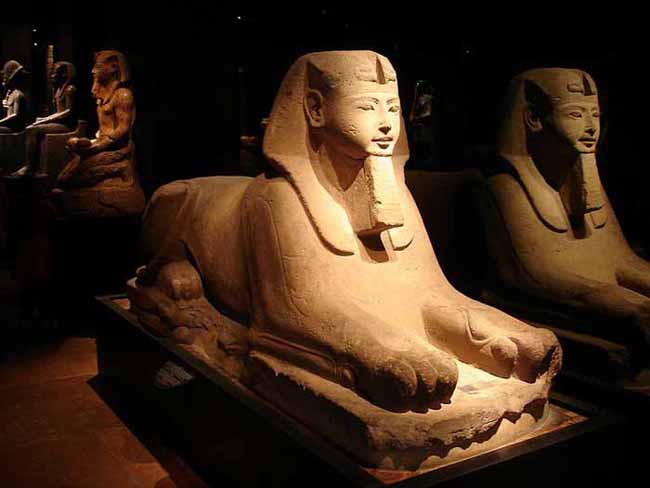
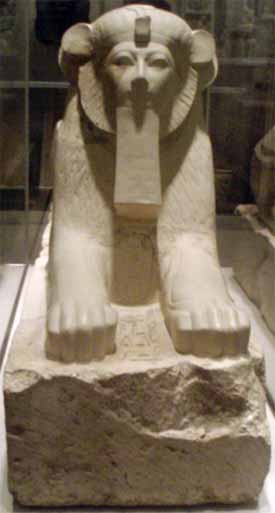
Sphinx of Egyptian pharaoh Hatshepsut with unusual ear and ruff features, 1503-1482 BC
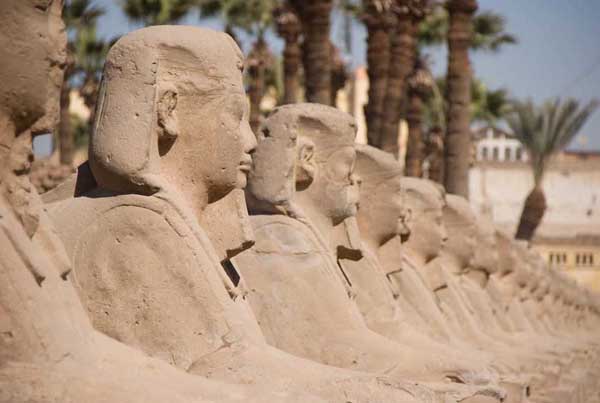
Row of Sphinx from Luxor to Karnak
The Great Sphinx was believed to stand as a guardian of the Giza Plateau, where it faces the rising sun. It was the focus of solar worship in the Old Kingdom, centered in the adjoining temples built around the time of its probable construction. Its animal form, the lion, has long been a symbol associated with the sun in ancient Near Eastern civilizations. Images depicting the Egyptian king in the form of a lion smiting his enemies appear as far back as the Early Dynastic Period of Egypt.
During the New Kingdom, the Sphinx became more specifically associated with the god Hor-em-akhet (Greek Harmachis) or Horus at the Horizon, which represented the Pharaoh in his role as the Shesep ankh of Atum (living image of Atum). A temple was built to the northeast of the Sphinx by King Amenhotep II, nearly a thousand years after its construction, dedicated to the cult of Horemakhet.
A composite mythological being with the body of a lion and the head of a human being is present in the traditions, mythology and art of South and South-East Asia Variously known as purushamriga (Sanskrit, "man-beast"), purushamirukam (Tamil, "man-beast"), naravirala (Sanskrit, "man-cat") in India, or as nara-simha (Sanskrit, "man-lion") in Sri Lanka, manusiha or manuthiha (Pali, "man-lion") in Myanmar, and nora nair or thepnorasingh in Thailand.
In contrast to the sphinx in Egypt, Mesopotamia, and Greece, where the traditions largely have been lost due to the discontinuity of the civilization, the traditions of the "Asian sphinx" are very much alive today. The earliest artistic depictions of "sphinxes" from the South Asian subcontinent are to some extent influenced by Hellenistic art and writings. These hail from the period when Buddhist art underwent a phase of Hellenistic influence. But the "sphinxes" from Mathura, Kausambi, and Sanchi, dated to the third century BC until the first century AD, also show a considerable non-Hellenist, indigenous character. It is not possible, therefore, to conclude the concept of the "sphinx" originated through foreign influence.
In South India, the "sphinx" is known as purushamriga (Sanskrit) or purushamirukam (Tamil), meaning "man-beast". It is found depicted in sculptural art in temples and palaces where it serves an apotropaic purpose, just as the "sphinxes" in other parts of the ancient world. It is said by the tradition, to take away the sins of the devotees when they enter a temple and to ward off evil in general. It is therefore often found in a strategic position on the gopuram or temple gateway, or near the entrance of the Sanctum Sanctorum.
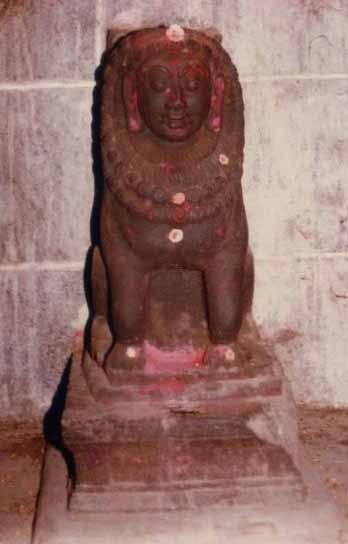
The purushamriga plays a significant role in daily as well as yearly ritual of South Indian Shaiva temples. In the sodasa-upacara (or sixteen honors) ritual, performed between one to six times at significant sacred moments through the day, it decorates one of the lamps of the diparadhana or lamp ceremony. And in several temples the purushamriga is also one of the vahana or vehicles of the deity during the processions of the Brahmotsava or festival.
In Kanya Kumari district, in the southernmost tip of the Indian subcontinent, during the night of Shiva Ratri, devotees run 75 kilometres while visiting and worshiping at twelve Shiva temples. This Shiva Ottam (or Run for Shiva) is performed in commemoration of the story of the race between the Sphinx and Bhima, one of the heroes of the epic Mahabharata.
The Indian conception of a sphinx that comes closest to the classic Greek idea, is in the concept of the Sharabha, a mythical creature, part lion, part man and part bird, and the form of Sharabha that god Shiva took on to counter Narasimha's violence.
In Philippines, the sphinx is known as nicolonia. It is depicted as part man and part eagle that is known to ask riddles to wanderers who trespass in the Bicol region. Anyone who fails to answer its riddle is said to be carried off to the Mayon Volcano where they are said to be offered to the volcano god, Gev'ra, to appease his anger.
In Sri Lanka, the sphinx is known as narasimha or man-lion. As a sphinx, it has the body of a lion and the head of a human being, and is not to be confused with Narasimha, the fourth reincarnation of the deity Vishnu; this avatara or incarnation is depicted with a human body and the head of a lion. The "sphinx" narasimha is part of the Buddhist tradition and functions as a guardian of the northern direction and also was depicted on banners.
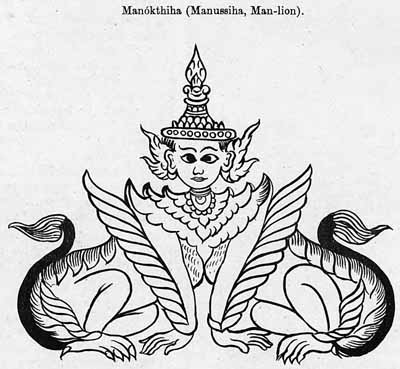
In Burma, the sphinx is known as manussiha (manuthiha). It is depicted on the corners of Buddhist stupas, and its legends tell how it was created by Buddhist monks to protect a new-born royal baby from being devoured by ogresses.
Nora Nair and Thep Norasingh are two of the names under which the "sphinx" is known in Thailand. They are depicted as upright walking beings with the lower body of a lion or deer, and the upper body of a human. Often they are found as female-male pairs. Here, too, the sphinx serves a protective function. It also is enumerated among the mythological creatures that inhabit the ranges of the sacred mountain Himapan.
The revived Mannerist sphinx of the sixteenth century is sometimes thought of as the French sphinx. Her coiffed head is erect and she has the breasts of a young woman. Often she wears ear drops and pearls as ornaments. Her body is naturalistically rendered as a recumbent lioness. Such sphinxes were revived when the grottesche or "grotesque" decorations of the unearthed "Golden House" (Domus Aurea) of Nero were brought to light in late fifteenth century Rome, and she was incorporated into the classical vocabulary of arabesque designs that spread throughout Europe in engravings during the sixteenth and seventeenth centuries. Sphinxes were included in the decoration of the loggia of the Vatican Palace by the workshop of Raphael (1515–20), which updated the vocabulary of the Roman grottesche.
The first appearances of sphinxes in French art are in the School of Fontainebleau in the 1520s and 1530s and she continues into the Late Baroque style of the French Regence (1715–1723).
From France, she spread throughout Europe, becoming a regular feature of the outdoors decorative sculpture of eighteenth-century palace gardens, as in the Upper Belvedere Palace in Vienna, Sanssouci Park in Potsdam, La Granja in Spain, Branicki Palace in Bialystok, or the late Rococo examples in the grounds of the Portuguese Queluz National Palace (of perhaps the 1760s), with ruffs and clothed chests ending with a little cape.
Sphinxes are a feature of the neoclassical interior decorations of Robert Adam and his followers, returning closer to the undressed style of the grottesche. They had an equal appeal to artists and designers of the romantic, and later symbolism movements in the nineteenth century. Most of these sphinxes alluded to the Greek sphinx, rather than the Egyptian, although they may not have wings.
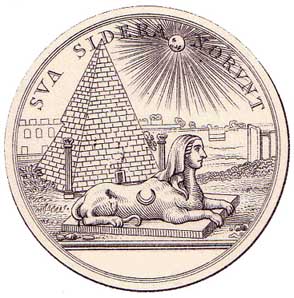
The sphinx image also has been adopted into Masonic architecture. Among the Egyptians, sphinxes were placed at the entrance of the temple to guard the mysteries, by warning those who penetrated within, that they should conceal a knowledge of them from the uninitiated. Champollion says that the sphinx became successively the symbol of each of the gods, by which Portal suggests that the priests intended to express the idea that all the gods were hidden from the people, and that the knowledge of them, guarded in the sanctuaries, was revealed to the initiates only.
As a Masonic emblem, the sphinx has been adopted in its Egyptian character as a symbol of mystery, and as such often is found as a decoration sculptured in front of Masonic temples, or engraved at the head of Masonic documents. It cannot, however, be properly called an ancient, recognized symbol of the Order. Its introduction has been of comparatively recent date, and rather as a symbolic decoration than as a symbol that announces any dogma.
The 32,000 year old Aurignacian Löwenfrau Goddess is the oldest known anthropomorphic statue. Previously known as the Lion man, she has a human female body and a lioness head.
Not all human-headed animals of antiquity are sphinxes. In ancient Assyria, for example, bas-reliefs of shedu bulls with the crowned bearded heads of kings guarded the entrances of the temples.
In the classical Olympian mythology of Greece, all the deities had human form, although they could assume their animal natures as well. All the creatures of Greek myth who combine human and animal form are archaic survivals: centaurs, Typhon, Medusa, Lamia.
Narasimha ("man-lion") is described as an incarnation (avatar) of Vishnu within the Puranic texts of Hinduism who takes the form of half-man / half-Asiatic Lion, having a human torso and lower body, but with a lion-like face and claws.
The Manticore is a similar creature, who also features a lion's body with human-like face.
![]() There is a temple under the Sphinx.
There is a temple under the Sphinx.
![]() There is a UFO between the Sphinx and The Great Pyramid.
There is a UFO between the Sphinx and The Great Pyramid.
![]() A record of the lost city of Atlantis lies somewhere under the Sphinx's paws in the Hall of Records.
A record of the lost city of Atlantis lies somewhere under the Sphinx's paws in the Hall of Records.
The 32,000 year old Aurignacian Löwenfrau Goddess is the oldest known anthropomorphic statue. Previously known as the Lion man, she has a human female body and a lioness head.
Not all human-headed animals of antiquity are sphinxes. In ancient Assyria, for example, bas-reliefs of shedu bulls with the crowned bearded heads of kings guarded the entrances of the temples.
In the classical Olympian mythology of Greece, all the deities had human form, although they could assume their animal natures as well. All the creatures of Greek myth who combine human and animal form are archaic survivals: centaurs, Typhon, Medusa, Lamia.
Narasimha ("man-lion") is described as an incarnation (avatar) of Vishnu within the Puranic texts of Hinduism who takes the form of half-man / half-Asiatic Lion, having a human torso and lower body, but with a lion-like face and claws.
The Manticore is a similar creature, who also features a lion's body with human-like face.
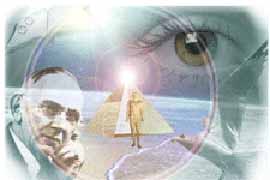
According to Edgar Cayce, the Sphinx was built in 10,500 BC by survivors of the vanished civilization of Atlantis.
In the bedrock under the Sphinx they had built a Hall of Records containing all the wisdom of that civilization. The opening to the Hall of Records which holds the history of the Earth, will be found in the right shoulder of the Sphinx.
If you bisect the golden mean that fits around the spiral at the Giza plateau, it passes exactly through the headdress of the Sphinx. Also, extended from the southern face of the middle pyramid and the line that bisects the golden mean, forms a cross that marks a very specific spot on the right shoulder of the Sphinx.
Cayce gave the date of the opening of the Hall of Records between 1996 -1998 by certain chosen people. He was not correct. He said that this was all relative to the level of consciousness of humanity at that time. They had to be ready to receive the information.
These claims, and the astronomical and archaeological data upon which they are based, have been refuted by scholars who have examined them, notably the astronomers Ed Krupp and Anthony Fairall. The refuting evidence includes noting that the correspondence of the angles between the pyramids and the angles in Orion's Belt at that epoch is not in fact precise or even very close, that the Age of Leo (period when the Sun's path appears in this constellation at the equinoxes) in fact starts 1500 years later than this, that the Zodiac of western astrology is known to have originated in Mesopotamia and not pre-ancient Egypt, and that if the Sphinx is meant to represent Leo, then it should be on the other side of the Nile (the "Milky Way") from the pyramids ("Orion").
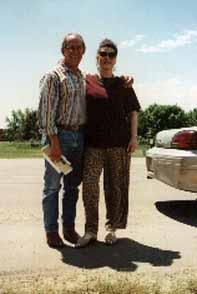
I met Drunvalo Melchizedek in June 1996 while attending the first Star Knowledge Conference in South Dakota. Drunvalo said that he had met Thoth in the Sphinx where he allegedly told Drunvalo ...
The head of the sphinx will fall off one day. A large golden sphere, which is a time capsule, will be found in the neck. 148 sets of three people would try to enter the Halls of Records, until one of these sets, coming from the West, would open the doorway by making a sound with their voice. Inside there would be a spiral staircase going into an underground room. These three people eventually will come down a long stone hallway lit on its own with no lights; that is, the air itself would be luminous.
High up on the left side of the wall would be etched forty-eight sacred geometry drawings. These are the illustrations of the chromosomes of Christ-consciousness. The first one being the 'flower of life'. At the end of the hallway there is a slight right-hand turn into a large room. Sitting on the raised shelves of this room is physical evidence of the existence of a civilization on this planet for the last five and a half million years.
At the front of the room is a stone. At the top of the stone these three people would find something like a photographic representation of themselves. Beneath the images in the photograph they would find their names - not necessarily the names they were given at birth, but their soul names. Underneath the names would be a date, which would be that date. Each of these three people will be allowed to remove one of these objects and take it out.